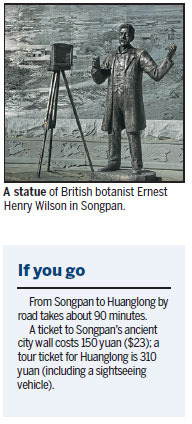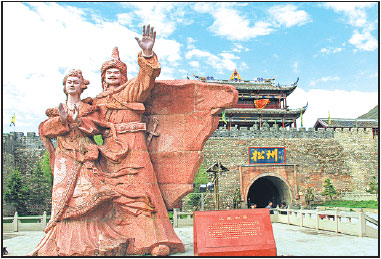Songpan's charm lingers and shines in modern times
Updated: 2016-02-12 08:26
By Li Yang In Aba, Sichuan(China Daily)
|
||||||||
Ernest Henry Wilson visited Songpan, an ancient city in Sichuan province, a few times beginning in 1903 to take back with him seeds to the United Kingdom.
Back then, Songpan used to be an important source of biodiversity because of its location near the origin of Minjiang River, between the Qinghai-Tibet Plateau and the Sichuan Basin.
During his visits, the late British botanist took many photos of the city and praised its weather, landscape, ethnic food and culture in eulogies.
Multiethnic Songpan in Southwest China retains its charm today.
The local government has installed a statue of Wilson to honor his contributions in making Songpan known to the world by way of photos and writings. They have also served as ready references for the authorities while rebuilding parts of the ancient structures other than the city's well-preserved wall.
Songpan was a hub for trade in tea, herbs, salt and cattle between western China and Central Asia, as well as a base for imperial China's military forces since the Tang Dynasty (AD 618-907).
The city's profile rose further in the early Ming Dynasty (1368-1644), when a general from northern China built a wall with many gates and watch towers.

The wall of black bricks, made from rocks of a nearby mountain, is more than 6 kilometers long and 12 meters high.
The watch towers are taller and broader compared with similar structures in Nanjing, the first Ming capital, in East China's Jiangsu province. The gates of the wall feature delicate stone carvings that date back 400 years.
Late Ming rulers consolidated the 60-year-old wall project, making Songpan one of the country's most impenetrable cities at the time.
The Red Army crossed Songpan from 1935-36 during their historic Long March. The communist troops were on their way to North China.
The city gates served as shelters from air raids during the War of Resistance Against Japanese Aggression (1937-45). On a gate in the wall that faces Wilson's sculpture, there are also some bullet holes made in 1944 by the Japanese forces as they targeted Chinese civilians.
Around the city are many ruins of ancient battlefields. In the Minjiang River Valley and Peijiang River Valley, travelers can easily spot mountain passes, barracks and beacon towers.
The city perches on a mountain slope with a river running through it. Most of the buildings in Songpan are in traditional Tibetan and Qiang styles, the two main ethnic groups in the region.
Songpan was an important spiritual destination in the past, as evident from more than a dozen Buddhist, Taoist and Confucian temples, as well as a few mosques.
About 57 kilometers to the east of Songpan is the Huanglong Scenic Area, a must-see spot for tourists. It is famous for its colorful calcified water bodies that are surrounded by primeval forests, near the origin of the Peijiang River. The color of water changes with sunlight and the seasonal changes in trees, creating a fantasy land.
|
Statues of ancient Tibetan king Songtsen Gampo and the princess guard the old city gate of Songpan in Sichuan province. Photos Provided To China Daily |
(China Daily 02/12/2016 page10)
- ASEAN wants good US-China relations
- Jury finds NYPD's Liang guilty in fatal shooting
- Major powers agree on plan to break Syria deadlock
- Munich Security Conference opens amid concerns
- General strike against pension reform brings Greece to standstill
- Madrid airport sounds alarm after bomb threat on Saudi plane

 Spectacular Harbin snow sculptures draw holidaygoers
Spectacular Harbin snow sculptures draw holidaygoers
 First Capitol billing for Lunar New Year
First Capitol billing for Lunar New Year
 All you need to know about China's Spring Festival temple fairs
All you need to know about China's Spring Festival temple fairs
 Special souvenirs
Special souvenirs
 Opening bell on Chinese New Year's Day
Opening bell on Chinese New Year's Day
 The world celebrates Spring Festival with China
The world celebrates Spring Festival with China
 Ditan Park temple fair embraces Chinese New Year
Ditan Park temple fair embraces Chinese New Year
 Xi Jinping grieves over Taiwan quake, vows aid
Xi Jinping grieves over Taiwan quake, vows aid
Most Viewed
Editor's Picks

|

|

|

|

|

|
Today's Top News
National Art Museum showing 400 puppets in new exhibition
Finest Chinese porcelains expected to fetch over $28 million
Monkey portraits by Chinese ink painting masters
Beijing's movie fans in for new experience
Obama to deliver final State of the Union speech
Shooting rampage at US social services agency leaves 14 dead
Chinese bargain hunters are changing the retail game
Chinese president arrives in Turkey for G20 summit
US Weekly

|

|









